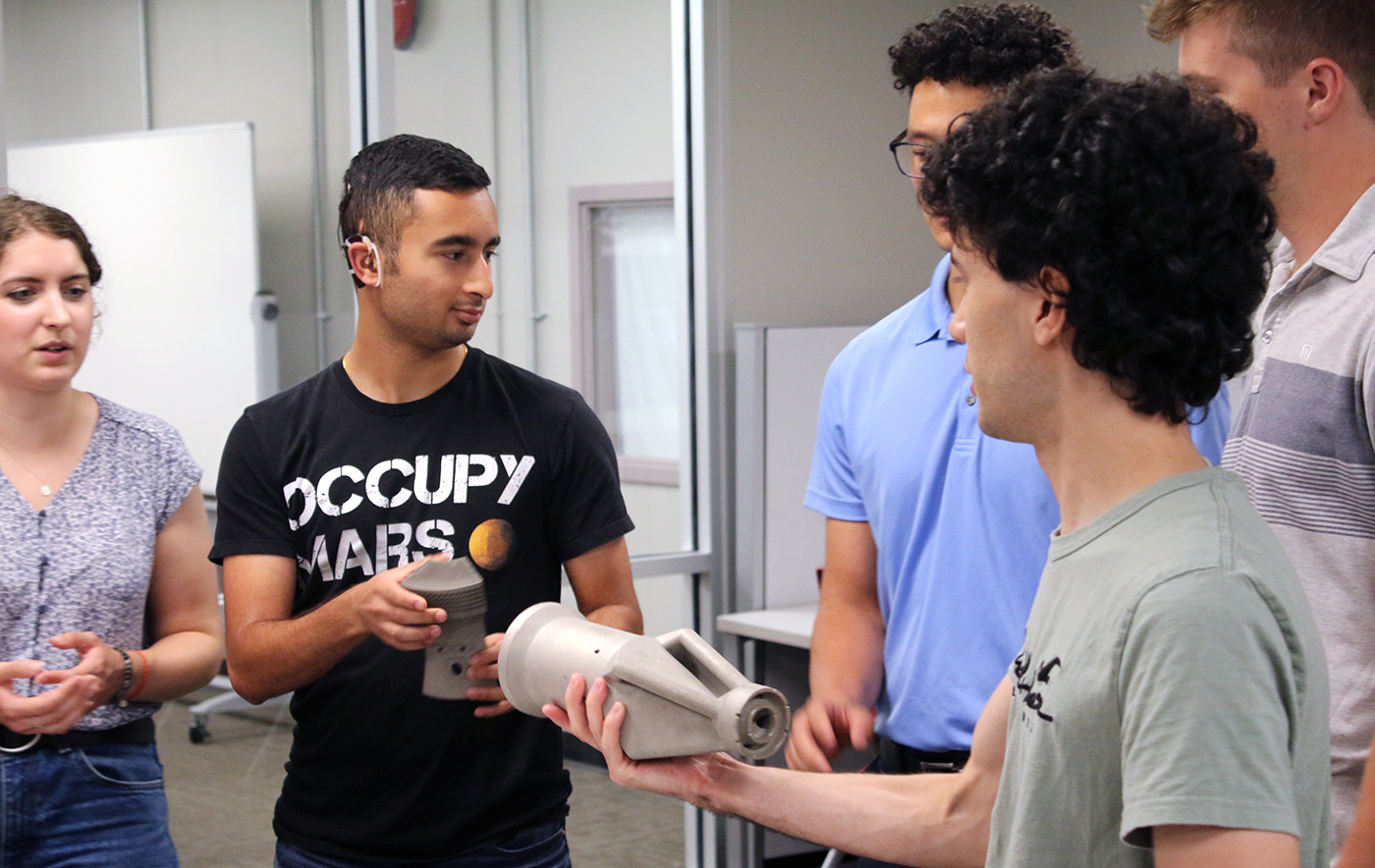The next generation: Using metal AM to drive emissions reduction and educate the engineers of the future
Metal Additive Manufacturing is a foundational technology for power generation, supporting the prototyping, testing, and design of gas turbines, as well as opportunities in repair and new components. The technology's future is also dependent on educating a new generation of engineers. Ohio State University’s Center for Design and Manufacturing Excellence (CDME), leading efforts to mature AM through the formation of an ecosystem of partners, has formed a collaboration with Siemens Energy and Engie to explore these topics and provide its students with experiential learning in metal AM. [First published in Metal AM Vol. 8 No. 3, Autumn 2022 | 10 minute read | View on Issuu | Download PDF]
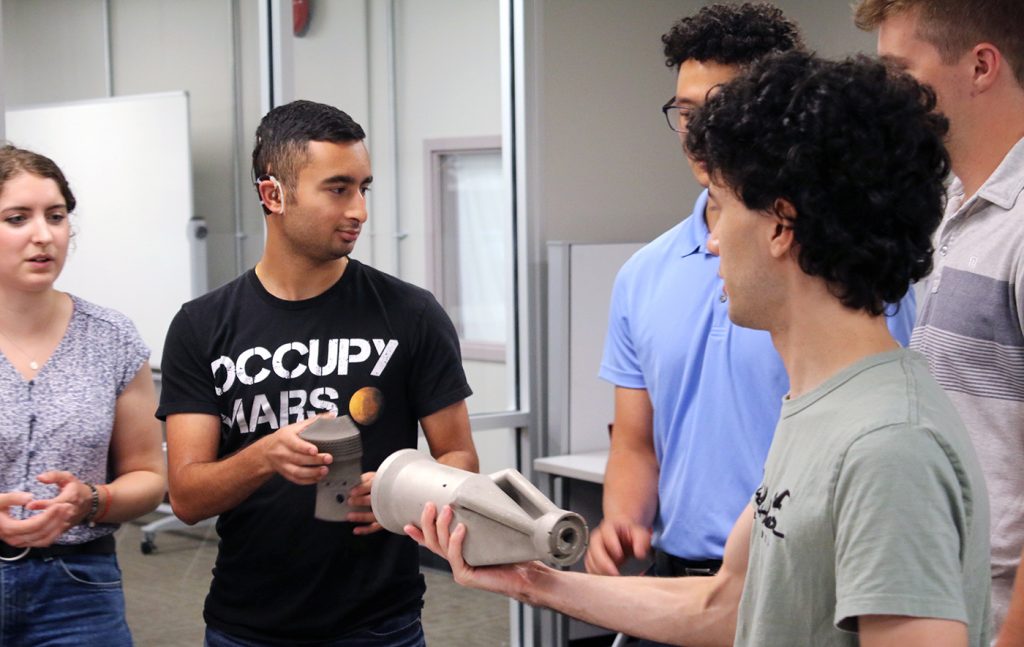
As the energy industry strives to achieve the necessary efficiency gains in gas turbine design and drive emissions reduction, metal Additive Manufacturing is being recognised as a valuable solution. Ohio State University’s Center for Design and Manufacturing Excellence (CDME) is leading efforts to develop and industrialise metal Additive Manufacturing by forming a network of new partnerships that will drive the capabilities and maturation of AM. This includes new alloy and process development, in-situ monitoring research, and industrialisation topics like multi-laser systems and beyond. CDME has formed a research collaboration with Siemens Energy and Engie to explore these topics and provide experiential learning opportunities for undergraduate students.
In 2017, Ohio State entered a fifty-year integrated solutions agreement with Ohio State Energy Partners (OSEP), a partnership between Engie North America and Axium Infrastructure. In 2019, the university-authorised OSEP to construct a state-of-the-art Combined Heat and Power (CHP) Plant in conjunction with a new district heating hot water and cooling loop. Two of the gas turbines that will generate the electricity and steam for the CHP are SGT-700 model turbines manufactured by Siemens Energy, with significant potential for the application of metal additively manufactured parts. As part of this collaboration, students had the chance to see industrial metal AM parts from Siemens Energy up close and tour the construction site where Engie and their partners are installing the CHP plant.
Bringing state-of-the-art gas turbines, with production enabled by industrial metal Additive Manufacturing, is an amazing opportunity for students at the university to directly learn about use cases like these and technical road maps for maturing AM technology.
Using metal AM will impact many components throughout the turbine, in particular design of the burners. Hydrogen has different combustion characteristics relative to natural gas, requiring design changes to the burner system. High flame speed makes the flame more compact and closer to the burner tip. This results in the heat being greater at the burner tip and, subsequently, a higher risk for flame flashback. With metal Additive Manufacturing, design improvements in the burner tip cooling (which can mitigate the higher heat load) are possible that could not be achieved conventionally.
Additive Manufacturing and experiential learning at CDME

The mission of CDME is to enhance America’s manufacturing competitiveness through the connection of advanced technology projects and undergraduate student training. The foundation is a world class 3,500 m2 manufacturing research laboratory, including more industrial metal AM equipment than any other university, with eleven full-scale metal AM machines and counting. CDME partners with more than 150 companies and has completed over 520 applied engineering projects. The facility is an experiential learning focused manufacturing centre with $14 million in manufacturing equipment; of that, $7 million is in industrial AM machines covering all seven ASTM Additive Manufacturing modalities. Fig. 2 shows a part of the Ohio State CDME Metal AM Lab.
CDME’s goal is to keep students at the centre of a growing ecosystem of partners, from end-users to machine manufacturers to engineers of the software powering the machines. To achieve that goal, undergraduate students get hands-on experiences with the equipment and software before they go into industrial practice. Students learn to maintain and operate Laser Beam Powder Bed Fusion (PBF-LB), laser-based Directed Energy Deposition (DED), Binder Jetting and beyond, with more niche processes on hand including Fabrisonic’s Ultrasonic Additive Manufacturing technology. This coupling of foundational engineering and technical expertise from coursework with hands-on project work prepares students to take on an active role in the metal AM industry.
CDME is currently leading a comprehensive portfolio of metal Additive Manufacturing projects, spanning alloy design and development, in-process monitoring and inspection, and new laser and machine controls for dramatically faster Additive Manufacturing. The focus is on the industrialisation of metal AM; this includes projects on such areas as stitching multi-laser PBF-LB parts, dynamic focus multi-modal laser beam profiles and their effects on speed and microstructure, and advanced in-process quality monitoring.
One of the most exciting elements of the relationship between Ohio State, Engie and Siemens Energy is the convergence of one of the world’s leading metal AM research centres with the producers of state-of-the-art turbines, which will use more and more metal AM during their operational lives in order to reach energy efficiency and sustainability goals. This represents a unique research capability wherein students and faculty at Ohio State can partner with Siemens Energy and Engie to learn about real AM use cases and drive new monitoring technology. In the future, it is expected to open up research opportunities for the testing of metal AM parts produced at CDME in real-life applications.
Siemens Energy roadmap for revolutionising gas turbines using AM
Siemens Energy has committed to gradually increasing the hydrogen capability of its gas turbines to 100% by 2030. The first steps toward this renewable hydrogen vision have already been achieved, with the power generation unit developed by a project at a petrochemical plant in Brazil now using 60% hydrogen. The capability for co-firing using 75% hydrogen has also been officially realised for Siemens Energy SGT-600, SGT-700 and SGT-800 gas turbines. Using ‘green’ hydrogen – which is produced using renewable energy only – as a fuel for turbines will enable carbon emission-free power generation in the future.
The SGT-700 gas turbine was developed and manufactured at Siemens Energy (SE) in Finspång, Sweden, where a major portion of Siemens Energy’s AM research and development activities take place. The AM workshop in Finspång was inaugurated in February 2016 and is responsible not only for R&D projects in this field, but also the manufacture and repair of combustors and turbine components for a global fleet of gas turbines. An example of how the AM repair process differs from the conventional repair process is the fact that when repairing a turbine using AM, only a small part of the burner head, around two centimetres, is machined off and reconstructed with the Additive Manufacturing machine.
According to Vladimir Navrotsky, vice president of Technology & Innovation at Siemens Energy’s Industrial Application Service, the gas turbine burner repair process is now ten times faster and more efficient. “Nothing has to be produced in the traditional way with wasteful subtractive manufacturing; we use no more than precisely the amount of material required.” Since these AM processes, in the case of burner repair, use up to 80% less energy and, thus, produce fewer emissions, the new AM repair process is also more environmentally friendly.
Besides burner heads, other AM components – such as newly developed gas turbine pre-combustion swirlers, vanes and blades inserts, compressor impellers – are in commercial production at Siemens Energy. Other components, such as improved SGT-700 turbine vanes and heatshields, are being tested for market launch at the Finspång facility and in pilot projects (e.g., with the German utility company E.ON).
AM has many benefits for the complex assemblies and systems present in state-of-the-art gas turbines. As an example, SGT-700/800 gas turbine burners that used to be comprised of thirteen parts are now additively manufactured in a single piece and weigh 25% less. Thanks to AM, fuel pipes which were originally placed outside the burner in conventional models, can be routed internally, greatly reducing the risk of damage and leaks. Moreover, fuel passing through these pipes now acts as a coolant, reducing the burner tip temperature and extending the overall lifespan of the burner. Burners can also now be produced with a lattice structure inside that can only be produced by AM, which enhances fuel-air mixing efficiency and boasts a strong cooling effect. Fig. 3 shows an example of a gas turbine fuel burner produced by metal AM.
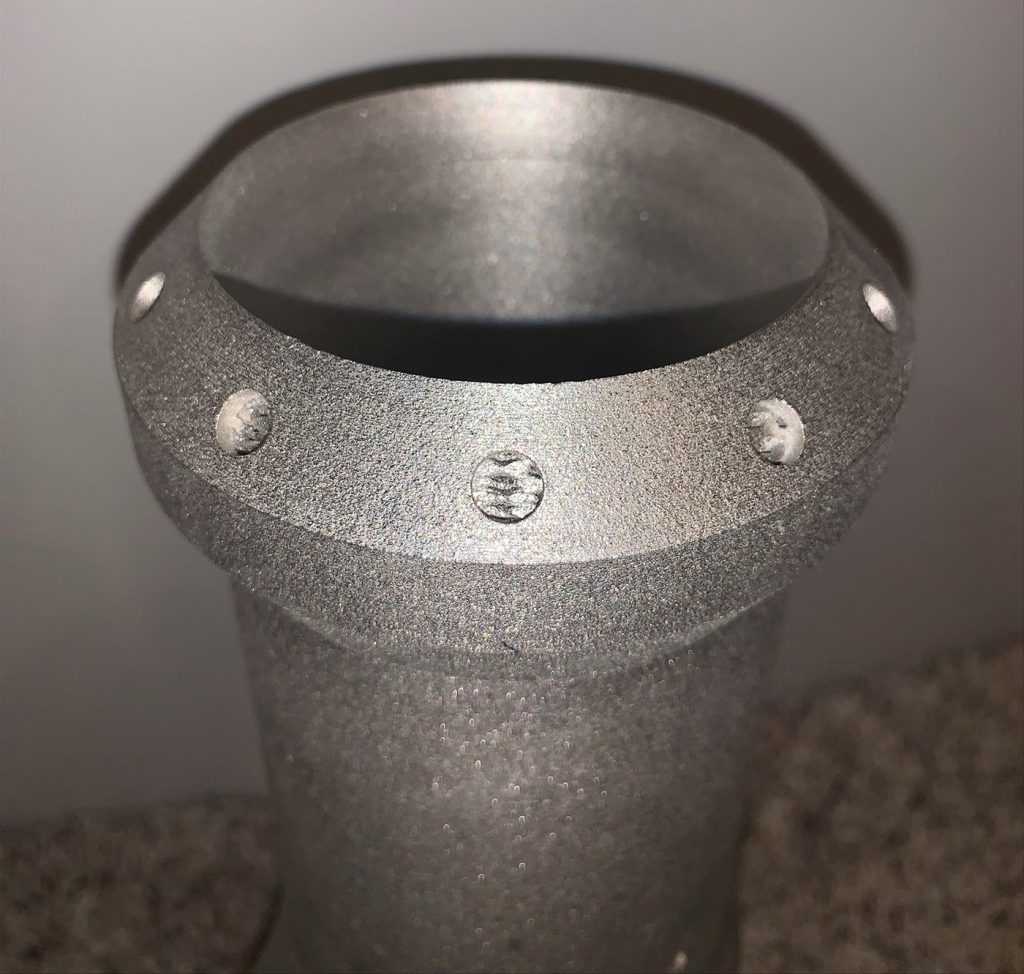
“This can reduce the burner tip temperature by up to 200°C,” explained Navrotsky. “This eliminates a source of damage and extend the burner life span.” But this is only the beginning: the Finspång team also developed the optimal lattice structure for utilising a mixture of natural gas and hydrogen in the burner. For some Siemens Energy customers, hydrogen is currently seen as a cheap alternative to natural gas because it’s a by-product of chemical processes. This “prompted us to modify the SGT-600, -700 & -800 burners to run on fuel mixture of natural gas and hydrogen,” stated Navrotsky. Now, it’s possible to use up to 75% hydrogen, resulting in significant annual fuel cost and emissions reduction compared with running the turbine on natural gas only. There are also specific design solutions for other fuels (e.g., biofuels).
The application of AM for turbine blades and vanes also enables the utilisation of advanced cooling systems and aerodynamic shapes that can only be achieved using this technology. Thirty years ago, Navrotsky researched the topic of turbine blade cooling for his PhD. Then, advanced cooling systems existed in concept, but the technology to actualise them didn’t exist. “Now, thanks to AM, we can realise these advanced cooling systems as well as their rigidity and weight. This gives us limitless design freedom. It’s one of those dreams that has come true. Now, we have the opportunity to install AM designed and manufactured SGT-700 turbine vanes at Ohio State and watch as efficiency increases, and emissions decrease, over time.”
A student experiential learning opportunity with Siemens Energy and Engie
In keeping with the CDME’s mission to provide experiential learning for undergraduate students, a collaborative meeting was held with Siemens Energy and Engie to build the collaboration. At this meeting, Siemens Energy staff highlighted a portfolio of their latest additively manufactured metal parts to show the students what’s possible – that these applications are real and not just in prototyping. “We really wanted to show the students that metal printing is not just in the classroom, but making it out into production applications,” stated CDME AM Technologist Ben DiMarco.
Fig. 4 shows a group of CDME student researchers examining the metal additively manufactured burner for the SGT-700. Undergraduates at CDME enjoyed seeing the real AM parts; according to Amanda Pizon, a CDME undergraduate researcher, “As a materials science student, it was really exciting to see metal printed parts up close. I really like the lattice and channels that can be metal printed.” Undergraduate student researcher Kiran Mokadam added, “I think it’s awesome that these parts are actually going into the power plant. It’s super exciting that metal printing is going to help the turbines run on hydrogen.”
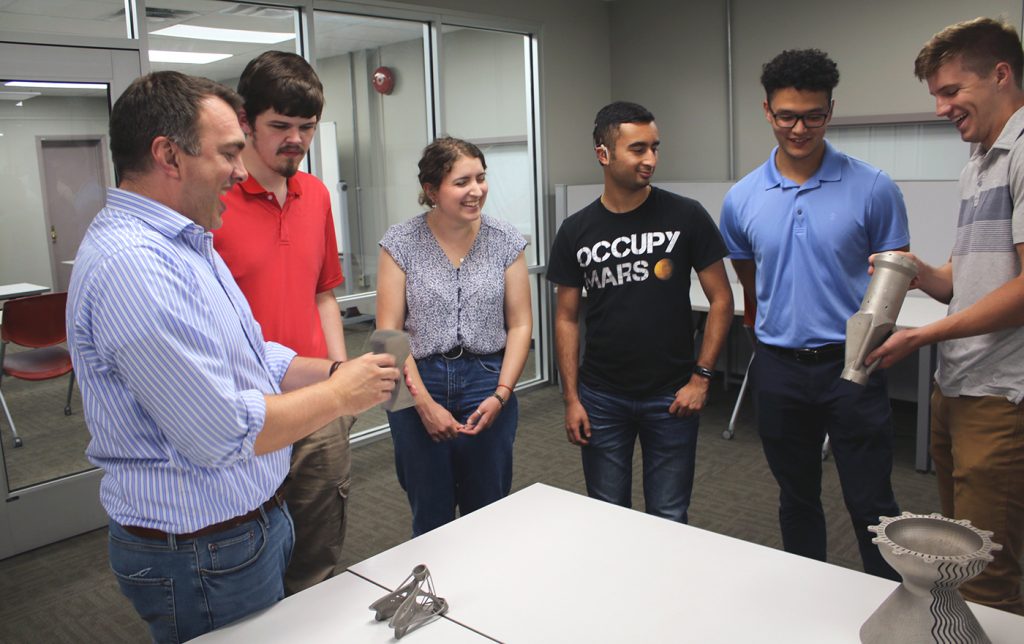
Subsequently, the local Engie team welcomed the CDME students and staff on a tour of the construction site to view the location where the two SGT-700 turbines are being installed at the new power plant (Fig. 5). On this tour, the CDME tour group was able to see where the fuel injection system is located inside the gas turbine, as well as the steam turbine system that comprises the second half of the overall CHP combined cycle, and toured the entire site to see the overall balance of the plant. This enabled the students to get to grips with the industrial reality of deploying metal Additive Manufacturing in the field.
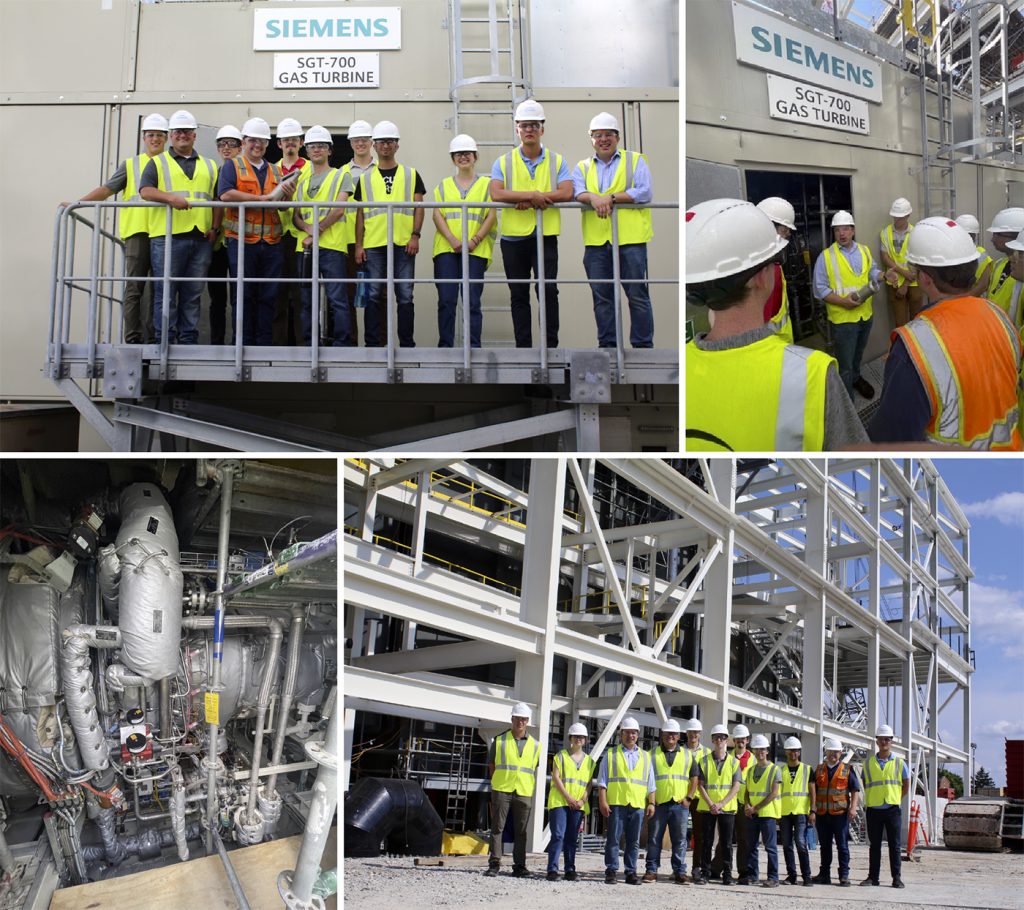
What is needed to be a great AM engineer? How should we be training the next generation?
The next generation of students, who will become the workforce and industry leaders of the future, will power the transition to low-carbon energy. One of the most enjoyable aspects of the collaboration between Ohio State, Siemens, and Engie is the ongoing discussion of what future engineers will need to be successful in the AM industry. We have defined the required experience and mindset that future AM engineers must have in order to have an impact in the industry. They must:
- Be open and think outside the box with Design for Additive Manufacturing (DfAM)
- Be able to integrate design and manufacturing together with the design of materials
- Possess different skills for different roles
- On the materials side, hold a deeply technical understanding of the technology and manufacturing process for metal powders and powder alloys
- Understand the chemical composition of materials initially developed for casting, and the influence of their combination with digitalisation and Integrated Computational Materials Engineering
- Understand how they as engineers fit into their business and their customers’ business (where are fixed costs and variable costs; how can AM improve operations?)
- Look at more than just part for part cost replacement. What about inventory costs? Save six months of inventory, less weight, fewer repairs, factory/supply chain risks?
- Have an enterprise business perspective that takes a holistic view, including sustainability benefits with less waste and inventory
- Understand Life Cycle Analysis and other drivers beyond just cost, all the way to recycling and remanufacturing
- Be able to assess what can be done from an organisational standpoint to accelerate innovation in AM
The team agreed that these points are essential for graduating Additive Manufacturing practitioners. Whether they’re engineers, business students, or in other majors, they should have an appreciation for the design and manufacturing benefits of AM, especially with a holistic perspective of how AM can impact the overall engineering design and operations of a materials-intensive manufacturing enterprise. These key points, combined with core engineering expertise, will prepare students to become the leaders who will continue to accelerate the metal AM industry’s growth.
Bringing it all together: the path forward
Industrial metal Additive Manufacturing is driving a revolution in gas turbine design, enabling the use of new fuels that will drive the low-carbon transition through the middle of this century. It is a foundational technology that should now be an essential component of an engineering education, as it will continue to grow in importance in manufacturing applications. According to Nate Ames, CDME Executive Director, “There’s an amazing metal AM ecosystem growing here in Ohio. Bringing together these thought leaders in metal printing and deployment will serve as an engine for accelerating the maturation and acceptance of AM.”
This unique collaboration between utility company Engie, gas turbine manufacturer Siemens Energy, and Ohio State University brings together the entire value stream for development all the way to the end-user and system maintenance using AM. This creates an amazing learning opportunity for the students, as well as pathways to accelerate the use of metal Additive Manufacturing to power a low-carbon future.
Author
Dr Edward D Herderick
Director of Additive Manufacturing
Center for Design and Manufacturing Excellence
The Ohio State University





